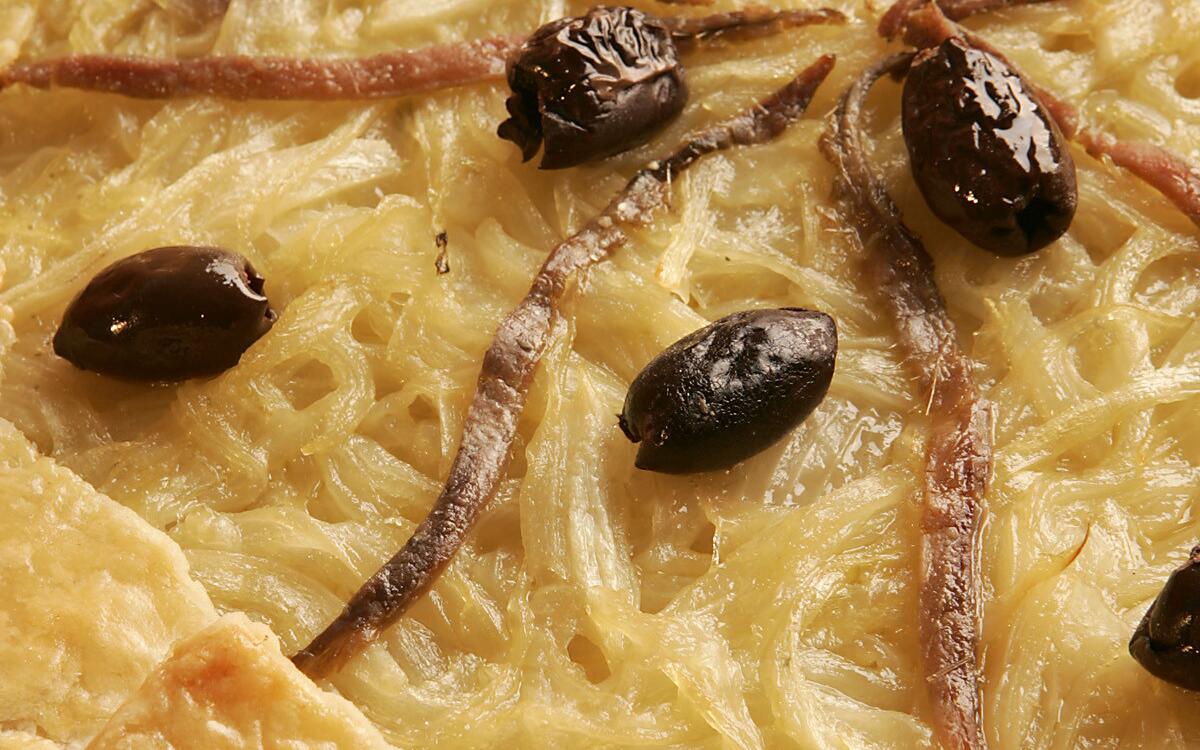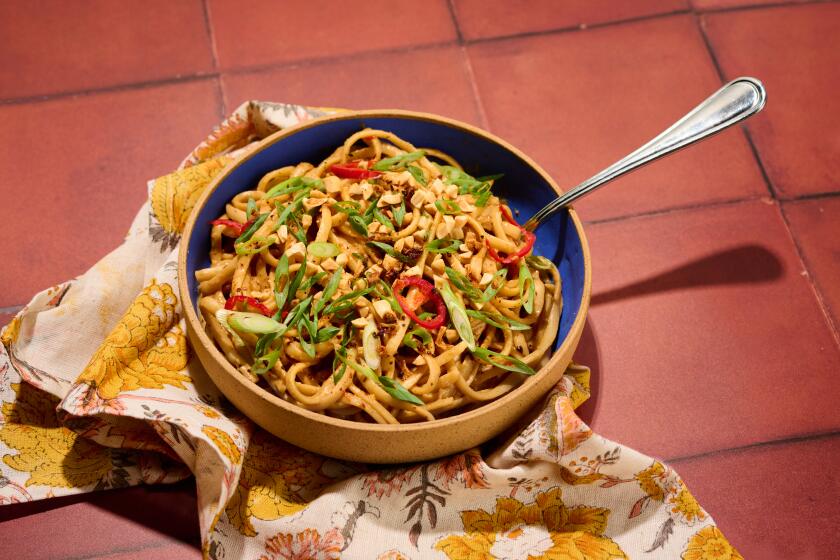Onion tart with anchovies and olives

Berkeley’s Chez Panisse Cafe -- the casual spot above the more famous restaurant -- is one of my favorite places in the world to eat. What I love about it is not its inventiveness, but rather the opposite. It does simple, seemingly obvious dishes perfectly, in a way that makes you appreciate them anew. I don’t recall ever looking at the menu and thinking, “Gee, I wonder how they did that”; instead I almost always think, “I can’t wait to taste that . . . and that . . . and that.”
The green salad, for instance. On the face of it, it’s pedestrian: a mix of greens, a vinaigrette, there you go. But the combination of flavors and textures of the lettuces is perfect, as is the balance of acid and oil, and the ratio of dressing to greens (just enough to moisten, never so much as to wet).
Every order gives me a deeper understanding of the virtues of a simple salad and makes me determined to go home and perfect it for myself.
This, in short, was what I was hoping to get from “The Art of Simple Food,” the new book from Chez Panisse founder Alice Waters. But “Art” is, quite simply, a bit of a mess.
Certainly, the seven previous books from the restaurant (also produced by Waters and her team of literary accompanists, including Fritz Streiff and Patricia Curtan) are among the most-used in my library. And the title certainly suggests that the book will be a “how-to” guide to achieving Chez Panisse’s brilliant simplicity. Indeed, the book seems to be organized with that intent: The chapters are arranged by technique -- roasting, frying, slow-cooking, simmering, grilling, etc. And each includes some general theoretical notes followed by three or four recipe examples, each with a handful of variations. In the second half of the book there are more recipes.
But instead of going for the specific, Waters went for the encyclopedic. Rather than a master cook’s teaching guide, what is delivered is nothing more than a compendium of standard formulas, a kind of au courant “Joy of Cooking.”
And instead of being the culinary bible for a new generation that I’d hoped for, it feels like nothing more than a tacked- together collection of sketchy recipes for dishes better presented elsewhere (including, in some cases, previous Chez Panisse books).
Does anyone really need another recipe for beef stew, even if it comes with the Chez Panisse imprimatur? Well, perhaps, if it was written in such a way that it helped you understand what separates a great stew from a good one. But, puzzlingly, what we get in “Art” is nothing more than a pretty standard version (brown the beef, reduce wine, braise beef, wine and stock with carrots, onions and a ton of garlic) told in only a little more detail than that.
‘Joy’ as the model
This is the problem with the “Joy of Cooking” model (which “Art” follows right down to the way the ingredients and techniques are interwoven and the typography used). The best editions of “Joy” were written as recipe collections at a time when our shelves were not sagging with cookbooks. And they were written for people who already knew how to cook and so could get by on fairly scant instruction.
Today, pretty much anybody who is likely to cook probably already has one or two standard recipe collections at least as good as “The Art of Simple Food.” And those who don’t are going to need a lot more instruction than “cook until done.”
The stew was pretty good, though there was so much liquid I’d consider it more of a daube. And, in fact, when I reheated the leftovers with some black olives (according to one of Waters’ variations), it was really good.
But while cooking it, I couldn’t help but think of Judy Rodgers’ “Zuni Cafe Cookbook,” which by its careful -- nearly neurotic -- description manages to teach so much more about cooking with far fewer (and, it must be said, more interesting) recipes. And of Thomas Keller’s “Bouchon,” with its careful observation and surprising twists of technique.
What I wanted to learn about the beef stew from Waters was what Keller calls the “points of finesse” in the recipe: which cuts to use and why; how to maintain heat during browning so you get deep color without scorching; what a perfect simmer looks like; what is the perfect texture for the meat; how do you balance the final seasonings to make the dish come alive.
In short, I want to know why this pretty good beef stew, if served at Chez Panisse, would surely be extraordinary. Waters offers no clue.
There are tidbits that deliver on the promise. The warmed olives are brilliant -- rinse regular olives, combine them in a pan with a little olive oil, a couple whole garlic cloves, some red pepper and some herbs and heat them just until they are warmed through. Even canned kalamatas come out tasting deep and bright. (Indeed, the “small dishes” section seems to be strongest: The roasted almonds with herbs were good, as were the cheese puffs.)
There are explanatory essays, certainly, and some of them are fairly helpful. With the onion tart, for example, it is correctly pointed out that onions will vary in juiciness according to season and storage and that really moist onions should be drained before being added to the tart shell.
But our trust is shaken by the recommendation immediately following that “sweet Walla Walla, Vidalia and Bermuda onions . . . bake up almost as sweet as honey.” In the first place, Bermudas may be sweeter than storage onions, but technically they are not sweet onions.
More important to a cook, true sweet onions such as Walla Walla and Vidalia aren’t actually sweeter than other types but are just lower in acid. They taste sweet when eaten raw but when cooked are about as honeyed as water.
In fact, perversely, given the nature of the restaurant and Waters’ admirable dedication to finding and supporting the finest small farmers, the book almost completely ignores the choosing of ingredients beyond the platitudinous recommendation to buy organic -- something that may be philosophically correct but certainly has nothing to do with predicting flavor.
After the beef stew, the onion tart, with a crisp, flaky crust and buttery sweet onions, was the most successful of the eight recipes I tested, though in a very low-key way. I used the variation that included half a dozen halved grape tomatoes, and it made a good appetizer when served with Champagne. It was even better topped with anchovies and black olives, a la pissaladiere.
The apple tart I tried another night was much less successful -- though perhaps this was due to a typographical error. The dessert used the same dough as the onion tart (both are actually free-form galettes), and it is a very good one -- easy to make even without a food processor or mixer -- and fun to work with.
But for one tart, the recipe calls for 3 pounds of apples, peeled, cored and sliced, which are somehow supposed to be arranged following maddeningly vague instructions, so that they wind up one-and-a-half layers deep. .
First off, if anyone can tell me how to arrange sliced apples one-and-a-half layers deep, I’ll be very grateful. I gave it my best shot, but after three attempts, I threw up my hands and just arranged the apples as best I could. And when I was done, I still had more than half of them left over. Checking other books (including Lindsey Shere’s splendid “Chez Panisse Desserts,” my pastry bible), I can’t help but think that there were supposed to be three apples, not 3 pounds.
Minor deviation
There was another puzzling deviation from the Shere book, though more minor. The recipe for oven-baked custard in “Art” instructs you to place the cups in the water bath and seal the pan tightly with aluminum foil. This resulted in trapped steam condensing on the foil lid and marring the surface of the custards. In “Desserts,” the instruction says to “just lay a sheet of foil on top” -- not seal it -- so the steam has a way to escape. The flavor is good either way, but the appearance is much better in the earlier version.
And as for that sparkling Chez Panisse green salad I so treasure? According to “Art,” it is based on a vinaigrette that starts by pounding a whole raw garlic clove to a paste for just four servings -- which turns out to be enough garlic to season everyone’s palate for the next three courses.
If you want the real version, you’ll have to go to the “Chez Panisse Cafe Cookbook” -- another of my favorites -- where you will find that the clove should be only bruised and then removed after the vinaigrette has steeped but before dressing the greens. That seemingly small change makes a huge difference, lending a slight garlicky sweetness to the dressing without overpowering it.
Actually, if you don’t already have it, you’d be much better off just buying that book in the first place. You’ll learn more and eat better with those few recipes than you would from “Art’s” many.
Place the butter and flour in a mixing bowl. Using a pastry blender or your fingertips, cut or work the butter into the flour, leaving some of the butter in fairly large, irregular pieces. This will take 1 or 2 minutes. (Or mix for no more than a minute at medium-low speed in a stand mixer fitted with the paddle attachment.)
Pour in 3 tablespoons cold water, stirring all the while with a fork until the dough begins to form clumps. (In the mixer, turn the speed to low and pour the water down the sides of the bowl, mixing for 30 seconds or less.) Add up to 1 additional tablespoon water if needed. Form the dough into a ball and wrap it in plastic. Flatten it into a disk and let rest, refrigerated, for 1 hour or longer.
Heat the oil or butter in a low-sided, heavy-bottomed pan. Add the onions and thyme. Cook over medium heat until the onions are soft and juicy, 20 to 30 minutes. Season with three-fourths teaspoon salt, or to taste, and cook for a few minutes more.
Transfer the onions into a bowl to cool. If the onions are very juicy, pour them into a strainer over a bowl to drain and remove the liquid.
Heat the oven to 375 degrees. Roll the tart dough out into a 14-inch circle on a lightly floured surface. Brush off the excess flour, transfer the dough to a large baking sheet lined with parchment paper, and put it in the refrigerator to firm up for 10 minutes or so.
Spread the cooled onions over the dough (removing the thyme sprigs as you go), leaving a 1 1/2 -inch border around the whole circumference of the dough. Fold the border up over the onions, overlapping the edges every 2 inches or so. Arrange the anchovies and olives evenly over the top. For a shiny, more finished appearance, mix together the egg and milk or water in a small bowl with a fork and brush the folded dough rim with it.
Bake until the crust is golden brown on the bottom, 45 to 50 minutes. Slide the tart off the pan onto a rack to cool. Serve warm or at room temperature.
Get our Cooking newsletter.
Your roundup of inspiring recipes and kitchen tricks.
You may occasionally receive promotional content from the Los Angeles Times.
















